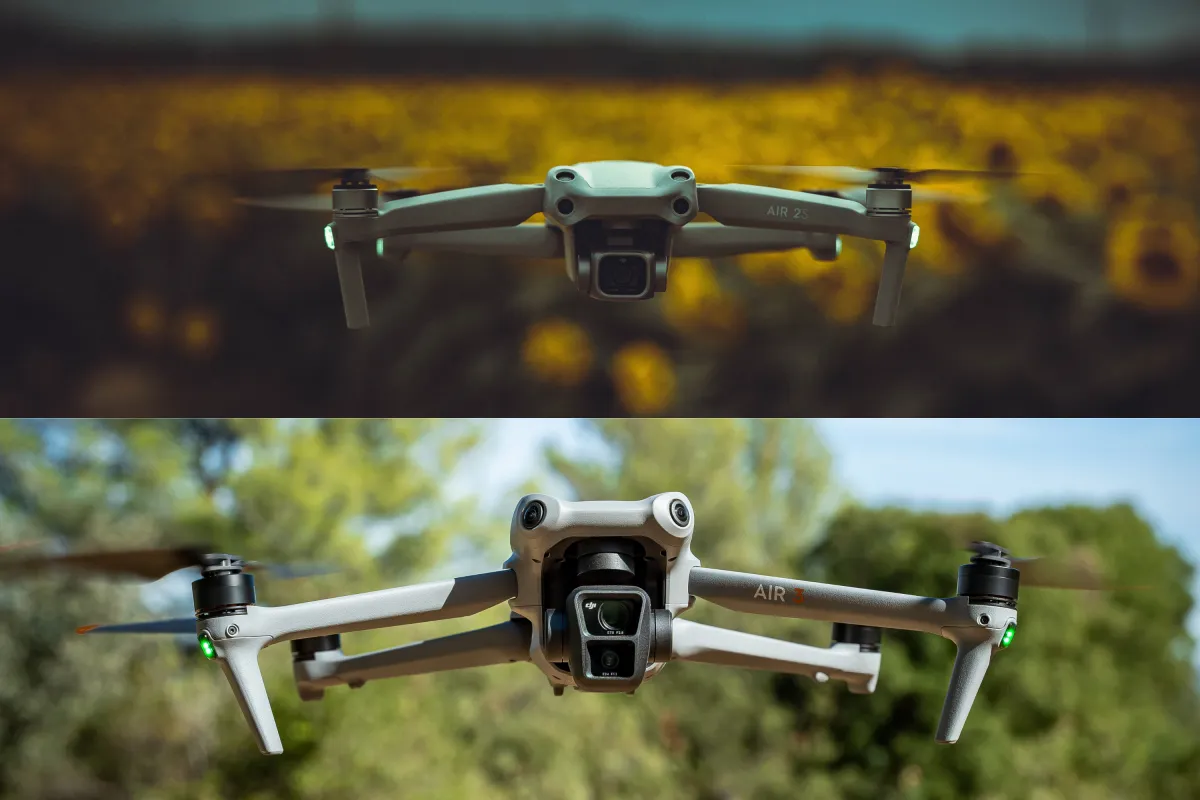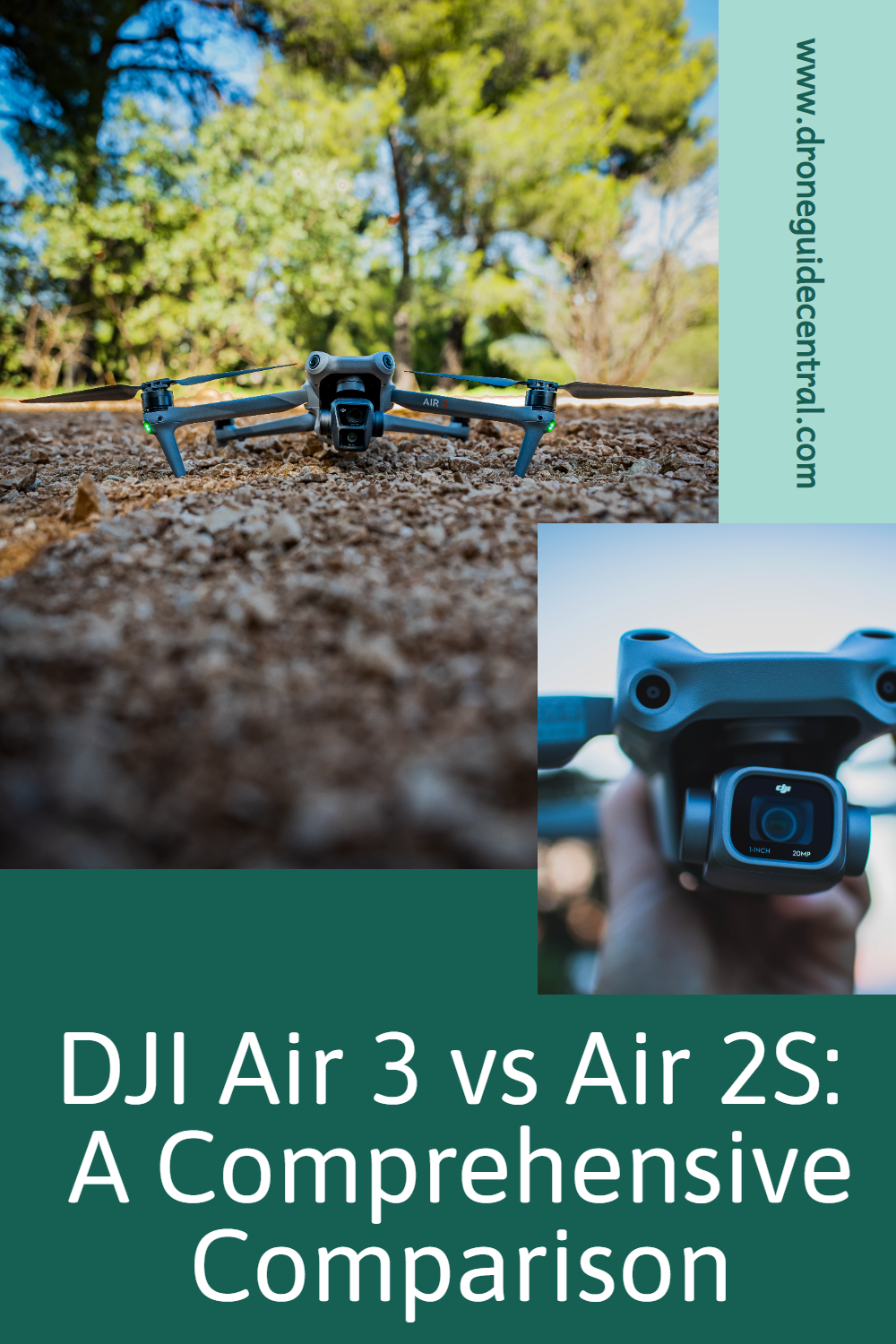
DJI Air 3 vs Air 2S: A Comprehensive Comparison
Welcome to an in-depth comparison of DJI Air 3 vs DJI Air 2S. I'm excited to guide you through the intricacies of these two impressive aerial companions. In this extended comparison, we'll explore every aspect of these drones, from design and performance to camera capabilities and smart features, to help you make a well-informed choice.
DJI Air 3 vs Air 2S: Drone Specifications
Let's begin by diving deeper into the specifications of the DJI Air 3 and the DJI Air 2S.
DJI Air 3
Design and Build
The DJI Air 3 is a well-engineered drone that strikes a balance between portability and performance. With a weight of 25.39 oz (720 g) and compact dimensions of 8.1x3.95x3.58 inches (207×100.5×91.1 mm), it's an ideal choice for travelers and adventurers.
Maximum Altitude and Speed
One of the standout features of the DJI Air 3 is its impressive maximum takeoff altitude of 19685 feet (6000 m). This means you can take your drone to higher altitudes, capturing breathtaking aerial views. It also boasts a top speed of 46.97 mph (21 m/s), ensuring that you can swiftly navigate through the skies.
Extended Flight Time
With a remarkable flight time of 46 minutes, the DJI Air 3 significantly outperforms many other drones in its class. This extended flight time opens up opportunities for more ambitious filming projects and exploration.
Wind Resistance
When it comes to flying in windy conditions, the DJI Air 3 can withstand winds of up to 26.8 mph (12 m/s), providing stability and confidence in varying weather conditions.
Max Ascent/Descent Speed
The DJI Air 3 features a max ascent and descent speed of 22.3 mph (10 m/s), allowing for rapid altitude changes and controlled descents.
Internal Storage
The DJI Air 3 comes equipped with 8 GB of internal storage, which is perfect for capturing a considerable amount of footage without the need for external memory cards.
Camera Capabilities
Dual Cameras for Versatility
The DJI Air 3 boasts a dual-camera setup that includes a wide-angle camera and a medium tele camera. Both cameras feature 1/1.3-inch CMOS sensors with an effective pixel count of 48 MP. This versatile setup allows you to switch between different angles and perspectives, ensuring you capture every moment perfectly.
Wide-Angle Camera
The wide-angle camera provides an impressive field of view (FOV) of 82° and has a format equivalent to 24 mm. This allows you to capture expansive landscapes and wide-angle shots with precision.
Medium Tele Camera
The medium tele camera offers a narrower FOV of 35° and has a format equivalent to 70 mm. This is ideal for close-ups and detailed shots with a beautifully blurred background, thanks to the f/2.8 aperture.
High-Quality Imaging
Both cameras support photo formats in JPEG and DNG (RAW), offering flexibility for post-production editing. The video resolution for both cameras is equally impressive, capable of shooting in 4K at 100fps and 2.7K at 60fps. Additionally, the color modes include HLG and D-Log M, ensuring that your footage is vibrant and versatile.
Digital Zoom
The DJI Air 3 takes the zoom capabilities up a notch with the wide-angle camera offering a 1-3x digital zoom and the medium tele camera providing a 3-9x digital zoom. This means you can capture distant objects with clarity, extending your creative possibilities.
Gimbal and Transmission
Stable Footage with 3-Axis Gimbal
Both drones feature 3-axis mechanical gimbals that provide stability during flights. The DJI Air 3, however, includes an omnidirectional system with an infrared sensor, enhancing its gimbal's precision.
Video Transmission System
The DJI Air 3 uses the O4 video transmission system, ensuring top-notch video quality. You can enjoy a live view with a resolution of 1080p at 30fps or 60fps, offering a clear and immersive flying experience. With an operating frequency range that includes 2.4 GHz and 5.8 GHz, the Air 3 provides a wide range of transmission options.
In terms of distance, it shines with a maximum transmission distance of up to 12.4 miles / 20 km (FCC), and 6.2 miles /10 km (CE, SRRC, MIC) thanks to its six antennas and 2T4R technology.
DJI Air 2S
Design and Build
The DJI Air 2S offers exceptional portability, being both lightweight and compact. It weighs just 20.98 oz (595 g) and folds down to compact dimensions of 7x3.8x3 inches (180×97×77 mm). Its sleek design makes it an attractive choice for those who value style and practicality.
Maximum Altitude and Speed
The Air 2S offers a maximum service ceiling of 16404 feet (5000 m) above sea level and a maximum flight speed of 42.5 mph (19 m/s). While slightly less than the Air 3, these specifications still make it a strong contender in its class.
Flight Time
With a flight time of 31 minutes, the Air 2S provides ample time for capturing stunning footage. While not as long as the Air 3's flight time, it is more than sufficient for most drone enthusiasts.
Wind Resistance
The Air 2S is equipped to handle wind speeds of up to 23.9 mph (10.7 m/s), ensuring stability during flight, even in moderately windy conditions.
Max Ascent/Descent Speed
The DJI Air 2S features a max ascent and descent speed of 13.4 mph (6 m/s), which allows for controlled and steady altitude changes.
Internal Storage
Similar to the Air 3, the Air 2S includes 8 GB of internal storage, making it easy to start flying and filming without the need for extra memory cards.
Camera Capabilities
Outstanding 1" CMOS Camera
The Air 2S features a single 1" CMOS camera with an effective pixel count of 20 MP. The camera offers an impressive 88° FOV and a 35 mm format equivalent of 22 mm. With an aperture of f/2.8, it's capable of delivering stunning images and videos.
Video Resolution
The Air 2S is no slouch in the video department, offering video resolutions of 5.4K at 30fps and 4K Ultra HD at 60fps. These high-resolution options ensure your footage is sharp and cinematic. It also supports shooting in 2.7K at 60fps and offers the flexibility of JPEG and DNG (RAW) formats.
Digital Zoom on DJI Air 2S:
4K at 30fps: Offers a 4x digital zoom for detailed shots from a distance.
2.7K at 60fps: Provides a 4x digital zoom, ensuring clarity in magnified shots.
2.7K at 30fps: Impressive 6x digital zoom for dynamic and detailed footage.
1080p at 60fps: Delivers a 6x digital zoom, enhancing versatility in capturing subjects.
1080p at 30fps: Offers an 8x digital zoom, allowing for extensive magnification in videos.
3-Axis Gimbal and Sensing System
The 3-axis gimbal on the Air 2S provides stability for capturing smooth and clear footage. Additionally, the drone features a sensing system that covers upward, forward, downward, and backward directions, enhancing its obstacle-avoidance capabilities. A single LED downward auxiliary light ensures that the drone maintains stability during low-light conditions.
Transmission System
The Air 2S utilizes the O3 transmission system, which can automatically switch between 2.4 GHz and 5.8 GHz frequencies. With a 4-antenna 2T4R setup, the Air 2S offers a maximum transmission distance of 7.4 miles / 12 km (FCC), and 4.97 miles / 8 km (CE, SRRC, MIC), ensuring a reliable connection.
DJI Air 3 vs Air 2S: Detailed Comparison
Now that we have a thorough understanding of the specifications, let's explore these two drones in more detail.
1. Design and Build
Both the DJI Air 3 and Air 2S have striking designs, but the Air 3's matte finish offers a premium look and enhanced durability. The Air 2S, with its sleek and lighter foldable design, is more about practicality and portability.
2. Maximum Altitude and Speed
The Air 3 outperforms the Air 2S in maximum altitude and speed. This advantage means you can explore higher altitudes and cover more ground in less time.
3. Flight Time
The Air 3 boasts an extended flight time of 46 minutes, making it an ideal choice for longer missions and cinematic shoots. The Air 2S, with its 31-minute flight time, still offers plenty of time for capturing captivating content.
4. Wind Resistance
Both drones exhibit impressive wind resistance, with the Air 3 at 26.8 mph (12 m/s) slightly edging out the Air 2S at 23.9 mph (10.7 m/s). The Air 3 is the better choice for flying in gustier conditions.
5. Internal Storage
With 8 GB of internal storage in both drones, you can begin flying and capturing content without worrying about additional memory cards. This is particularly convenient for spontaneous flights and quick setups.
6. Imaging Capabilities
The DJI Air 3's dual-camera configuration, featuring an impressive 48MP camera, offers enhanced versatility for both photographers and videographers. This setup enables seamless switching between wide-angle and medium telephoto perspectives.
On the other hand, the Air 2S, equipped with a 1" CMOS camera boasting 20MP, excels in delivering exceptional image and video quality, making it the ideal choice for individuals who prioritize top-tier image performance.
7. Video Resolution
While the Air 3 offers impressive video resolutions and digital zoom capabilities, the Air 2S shines with its 5.4K at 30fps and 4K Ultra HD at 60fps. Filmmakers and content creators will appreciate the cinematic quality of the Air 2S's footage.
8. Wildlife Observation
The Air 3's medium tele camera comes in handy for wildlife enthusiasts, allowing them to observe animals from a safe distance without disturbing their habitat.
9. Gimbal and Sensing System
Both drones are equipped with 3-axis gimbals that ensure stability and smooth footage. However, DJI Air 3 takes it a step further with its 360° obstacle avoidance capability. This feature provides peace of mind, especially when flying your drone sideways or in challenging scenarios where potential obstacles might come from any direction.
The Air 2S's sensing system provides reliable obstacle avoidance, making it a safe and secure choice for pilots.
10. Vertical Shooting
The DJI Air 3 offers the capability to shoot vertically with both of its cameras in 2.7K resolution, expanding your creative options for capturing stunning vertical content.
11. Low-Light Performance
In low-light conditions, the DJI Air 3 outperforms the Air 2S, providing better results with enhanced clarity and quality in challenging lighting situations.
12. Improved ActiveTrack
The ActiveTrack feature in the DJI Air 3 has been improved, offering more accurate and reliable tracking of subjects, whether you're capturing dynamic action shots or scenic footage.
13. Quieter Flight
The DJI Air 3 operates with less noise during flight, ensuring a quieter and less intrusive drone experience, perfect for maintaining a peaceful environment during your flights.
14. Transmission System
The transmission systems of both drones are excellent, providing clear live views and extended range. The DJI Air 3 is equipped with the latest O4 transmission technology, giving it a performance edge, particularly in urban areas. Additionally, the Air 3 leads the way with an impressive maximum transmission distance of up to 12.4 miles / 20 km (FCC).
The Air 2S offers a still-impressive 7.4 miles / 12 km (FCC), ensuring a robust connection for your flights.
15. Compatible Remote Controllers
When considering your drone purchase, it's essential to take into account compatibility with remote controllers, especially if you already own one.
The DJI Air 3 introduces the new O4 technology and a range of remote controllers to enhance your flying experience. DJI RC-N2 (used with a smartphone) and DJI RC (built-in 5.5" screen). It's worth noting that currently, the DJI Air 3 and Mini 4 Pro are the only drones compatible with these remote controllers, offering a seamless and customized flight experience.
The DJI Air 2S offers flexibility when it comes to remote controller compatibility, ensuring you have options for various DJI aircraft. DJI RC-N1: DJI Mini 2/ DJI Mavic Air 2 (O2), DJI Air 2S (O3), DJI Mavic 3 (O3+) and DJI RC with DJI RC Pro are both compatible with DJI Mavic 3 Pro Series, DJI Mavic 3 Series, DJI Mini 3 Pro, DJI Mini 3, DJI Air 2S.
When making your decision, consider the convenience and compatibility offered by these remote controllers, allowing you to make the most of your drone flying experience.
DJI Air 3 vs Air 2S: Conclusion
In conclusion, the choice between the DJI Air 3 and the DJI Air 2S depends on your specific requirements and priorities. The Air 3 introduces enhanced features, better low-light performance, longer flight times, and an advanced dual-camera setup, making it an attractive choice for those looking for the latest advancements in drone technology.
On the other hand, the Air 2S continues to stand out as an outstanding choice, delivering top-tier imaging quality and versatile performance. Both drones are exceptional in their own right, offering a wide range of possibilities for drone enthusiasts and content creators.
DJI Air 3 vs Air 2S: FAQs
1. Can I swap the camera modules on the DJI Air 3?
No, the camera modules on the DJI Air 3 are fixed and cannot be swapped.
2. Which drone is more budget-friendly?
The DJI Air 2S is generally more budget-friendly, making it an excellent choice for enthusiasts seeking a balance between performance and cost.
3. Do these drones support intelligent flight modes?
Yes, both drones come equipped with intelligent flight modes, such as ActiveTrack, QuickShots, MasterShots, and more, to enhance your aerial photography and videography experience.
4. What are the maintenance and servicing options for these drones?
DJI offers comprehensive maintenance and servicing options for their drones. You can purchase Care Refresh plans to protect your investment and receive support from DJI's service centers.
5. Can I attach third-party accessories to these drones?
While DJI offers a wide range of official accessories, you can often attach third-party accessories, such as ND filters and landing gear, to enhance your drone's capabilities. However, be sure to check compatibility and quality before making any purchases.
Make your choice wisely, and may your new drone bring you incredible aerial adventures!

Copyright © Drone Guide Central - All Rights Reserved 2024

